At any age, two-way radios never lose their cool factor. Two-way radios, or “walkie-talkies,” are a fun (and functional) way to communicate with friends, family, or other amateur radio enthusiasts across the country. For a technology that’s been around for over a hundred years, two-way radios are still going strong. They provide users with the nearly unmatched capability to stay in touch with one another in remote areas where cell phone reception can be unreliable —or non-existent.
The two-way radio market is flooded with an astonishing array of products, catering to every possible age demographic, price range, and level of expertise. We’ve extensively researched and sifted through what’s available to bring you the very best walkie-talkies for both adults and kids.
Whether you’re an aspiring member of the (still thriving) ham radio community, looking for the perfect birthday present for your little one, or gearing up for a camping trip or hiking expedition, you’ll be sure to find something on this list that fulfills your particular needs.
- Key Considerations When Buying a Walkie-Talkie
- Top 10 Best Two-Way Radios 2025
- 1. Best Overall Radio: BaoFeng UV-5R Dual Band Two-Way Radio
- 2. Best Premium Radio: BaoFeng 8 Watt Ham Radio
- 3. Best Budget Radio: Radioddity FS-T1
- 4. Best Radio for Kids: Obuby Walkie-Talkies for Kids
- 5. Motorola T100 Talkabout Radio
- 6. Retevis RT628 Walkie-Talkie for Kids
- 7. Radio With Best Battery Life: BaoFeng BF-888S
- 8. Selieve Toys Kids Walkie-Talkies
- 9. Best Wearable Radio: Wishouse Wearable Walkie-Talkie
- 10. Most Durable Radio: Midland GXT1000VP4 Two-Way GMRS Radio
- Be a Knowledgeable (and Responsible) Two-Way Radio Owner
- “Over and Out!”
Key Considerations When Buying a Walkie-Talkie
While there are a wide variety of bells and whistles to think about when deciding which two-way radio you’d like to purchase, it’s important not to overlook the fundamental considerations common to all these devices. Regardless of what type of walkie-talkie you’re after, the top things you’ll need to think about are:
Power Output
The wattage of your walkie-talkie is perhaps the most important factor to consider, as this determines the signal strength, range, and sound clarity of your device. Buyers should also be aware that the Federal Communications Commission (FCC) has slightly different rules and regulations for high and low-powered walkie-talkies.
For children, and the great majority of casual adult users, a two-way radio with a 0.5W to 2W power output should more than suffice. Any device at or below this 2W threshold (like the Radioddity FS-T1) is allowed to freely operate on the “Family Radio Service” (FRS) —a short-distance communications band that has been set aside for public usage. While your signal range will be more limited compared to higher powered models, such as the BaoFeng 8 Watt Ham Radio, FRS compliant walkie-talkies do not require a license to operate.
More serious two-way radio users who wish to communicate over longer distances will require a device with a power output above 2W. Walkie-talkies at this power level operate on the “General Mobile Radio Service” (GMRS) communications band. To legally use these public frequencies, users require a license from the FCC. Additional information on the FRS and GMRS systems —and how to obtain a license for the latter— will be detailed below.
Battery Life
As with any mobile device, the battery is one of the most crucial components of a walkie-talkie. Transmitting and receiving radio signals is quite an energy intensive process. Given that fact, it should come as no surprise that one of the biggest problems people encounter with walkie-talkies is their rather limited battery life.
The battery life of your two-way radio will depend on its power output, how frequently you use it, whether or not it’s equipped with any power-saving features, and (perhaps most significantly) what type of battery it uses. Models with rechargeable lithium-ion batteries, like the BaoFeng BF-888S, are by far the best option for prolonged battery life.
Unfortunately, almost every walkie-talkie engineered for the children’s market uses either AA or AAA batteries. Although we’ve only chosen products with the best possible battery life available (such as the Motorola T100 Talkabout Radio) we would still recommend purchasing rechargeable AA or AAA batteries. You’ll be changing them quite frequently if your child uses their walkie-talkie on a daily basis.
Privacy Codes
As there are a finite number of publicly accessible radio channels, you’re likely to run into “interference” if you live in a densely populated area. This happens when two or more radio users within a relatively close proximity to one another accidentally overlap on the same frequency. They will be able to hear and speak to you, and vice versa.
In order to avoid this annoying occurrence, you —and the person to whom you’re communicating— need to use the same “privacy code” on a mutually agreed upon channel. These privacy codes automatically tune out anyone else who happens to be transmitting on that channel so that you can hear each other clearly.
This feature is particularly important for kid’s walkie-talkies. You teach your child not to talk to strangers on the street, and there’s no reason why the airwaves should be an exception to that rule!
All but one of the two-way radios included on this list are equipped to use privacy codes, many of which come preprogrammed on the device for easy plug-and-play use. Privacy codes will also be discussed in further detail below.
Now that you know what to look for, let’s get into our picks for the best two-way radios for beginners, experts, and everyone in between.
| Product | VOX | Earpiece Included | Preprogrammed Privacy Codes | License Required | Maximum Range | Battery Type | Durability | Rating |
|---|---|---|---|---|---|---|---|---|
| BaoFeng UV-5R Dual Band Two-Way Radio | Yes | Yes | No | Yes | 2-3 miles | 1800mAh, 8-10 hours, 7.4V rechargeable lithium-ion | Very good; water resistant; flimsy charging station | 5 |
| BaoFeng 8 Watt Ham Radio | Yes | Yes | No | Yes (Technician Class) | 5-10 miles | 3,800mAh, 20 hour, 7.4v rechargeable lithium-ion | Excellent; water resistant; flimsy charge station | 5 |
| Radioddity FS-T1 | Yes | Yes | No | No | 5 miles | 1500mAh rechargeable lithium-ion, 2-5 hours | Good | 4.5 |
| Obuby Walkie-Talkies for Kids | Yes | No | Yes | No | 1.8 miles | AA, 3-5 hours | Excellent; waterproof | 4.5 |
| Motorola T100 Talkabout Radio | No | No | No, and not capable of being programmed | No | 0.5 miles | AAA, 18 hours | Average; water resistant | 4.5 |
| Retevis RT628 Walkie-Talkie for Kids | Yes | No | Yes | No | 1 mile | AA, 8-10 hours | Very good, water resistant | 4 |
| BaoFeng BF-888S | Yes | No | Yes | Yes | 3 miles | 1500mAh, 3.7V lithium-ion, 48 hours | Very good; water resistant | 4 |
| Selieve Toys Kids Walkie-Talkies | Yes | No | Yes | No | 2 miles | AA, 3-5 hours | Very good; not water resistant | 4 |
| Wishouse Wearable Walkie-Talkie | Yes | No | Yes | No | 3 miles | AA, 8-10 hours | Very good, water resistant | 3.5 |
| Midland GXT1000VP4 Two-Way GMRS Radio | Yes (adjustable) | Yes | Yes | Yes | 700mAh, 6.0V lithium-ion (or 4 AA), 10 hours | Excellent; splash proof | 3.5 |
Top 10 Best Two-Way Radios 2025
1. Best Overall Radio: BaoFeng UV-5R Dual Band Two-Way Radio

Editor’s Rating:
Quick Facts:
- VOX: Yes
- Earpiece Included: Yes
- Preprogrammed Privacy Codes: No
- License Required: Yes
- Maximum Range: 2-3 miles
- Battery Type: 1800mAh, 8-10 hours, 7.4V rechargeable lithium-ion
- Durability: Very good; water resistant; flimsy charging station
In terms of bang-for-your-buck, you aren’t likely to get better value than the BaoFeng UV-5R Dual Band Two-Way Radio. Not only is this compact device extremely economical, it’s also high-powered, programmable, and comes with a great variety of cool extras.
Its substantial 5W power output gives the UV-5R excellent range, and makes it capable of dual band transceiving in the Very High Frequency (VHF) and Ultra High Frequency (UHF) ranges. However, due to its higher power level, you’ll need to get a GMRS license to legally use it. The UV-5R also has a power-saver mode, which turns it down to only 1W. This will significantly prolong its battery life, up to twelve hours or so —though its signal range will be much shorter.
The UV-5R boasts a whopping 128 channels, and can utilize a total of 154 analog and digital privacy codes. Unfortunately, it doesn’t come preprogrammed with these, and the instruction manual can be overwhelming for beginners. To program it on your computer, you’ll need to purchase a specially-designed USB cable and install CHIRP —a free software program for two-way radios.
Other features include an FM Radio (listen only), a built-in LED flashlight, a keypad lock, a broad/narrowband toggle, an emergency siren and blinking light, and a Voice Activated Exchange (VOX) function that enables you to communicate without having to press the Push To Talk (PTT) button every time you speak.
The UV-5R is sturdy and resistant to light rain and splashes, but it isn’t completely waterproof like the ultra-durable Midland GXT1000VP4 Two-Way GMRS Radio. Unlike the device itself, the charging station is rather flimsily constructed.
Pros
- High power output
- Lots of privacy codes
- Very good battery life
- Extra features
Cons
- Steep learning curve for programming
- Flimsy charging station
- Sold individually
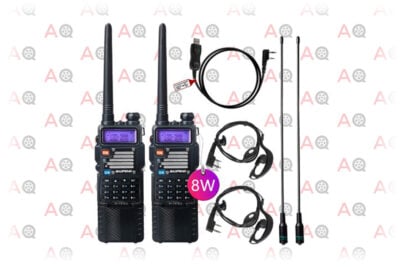
Editor’s Rating:
Quick Facts:
- VOX: Yes
- Earpiece Included: Yes
- Preprogrammed Privacy Codes: No
- License Required: Yes (Technician Class)
- Maximum Range: 5-10 miles
- Battery Type: 3,800mAh, 20 hour, 7.4v rechargeable lithium-ion
- Durability: Excellent; water resistant; flimsy charge station
With a massive 8W power output, this BaoFeng product the most powerful two-way radio on this list. Its lithium-ion battery is significantlylarger than its predecessor, making it capable of lasting up to 20 hours on a single charge. It also has 3 different power modes to help conserve the battery. This radio can transmit over 128 channels, and can run a total of 155 analog and digital privacy codes — though you’ll have to program these in yourself.
Combined with this hefty battery (which makes it slightly less portable than the UV-5R), it’s got two antennas (6 and 15 inches) antenna that give it an excellent range of over five miles on the VHF and UHF frequency ranges. It’s a perfect choice if you’re a beginner ham radio enthusiast who wants to connect with FM repeater stations and broadcast over long distances.
It’s outfitted with a reinforced, durable outer shell, which makes it nearly invulnerable to being damaged if dropped from a reasonable height. It’s also water resistant. However, like the UV-5R, its charging station isn’t as solidly constructed as the device itself.
Be warned: the high power output might cause it to interfere with local emergency responder frequencies in your area if you aren’t careful. Before using it, you will need to program it to stay off these particular frequencies.
Because its power output is above 5W, you will need to obtain a Technician Class license in order to legally operate it.
In terms of programming, the manual controls aren’t very intuitive, and the instruction manual can be somewhat mystifying for beginners. Luckily, BaoFeng does offer concierge tech support on this particular model. Similar to the UV-5R, you’ll also need to purchase a special USB cable and install CHIRP in order to program it on your computer.
Pros
- Extremely high-powered
- Excellent battery life
- Highly programmable
- Very durable
Cons
- Steep learning curve for programming
- Possible interference with emergency responder frequencies
- Bulky
- Sold individually
3. Best Budget Radio: Radioddity FS-T1
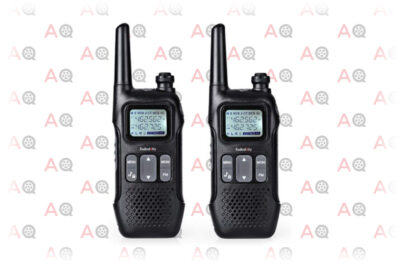
Editor’s Rating:
Quick Facts:
- VOX: Yes
- Earpiece Included: Yes
- Preprogrammed Privacy Codes: No
- License Required: No
- Maximum Range: 5 miles
- Battery Type: 1500mAh rechargeable lithium-ion, 2-5 hours
- Durability: Good
The Radioddity FS-T1 is a great option for casual two-way radio users who want a good quality device without having to obtain a license from the FCC. For a walkie-talkie with only a 2W power output, it’s got a fairly good range of 2-5 miles, and the sound clarity is excellent within this distance. They come in a set of two.
The FS-T1 is compact and lightweight, making it convenient to carry around in your pocket. The mechanical construction is quite solid and it’s outfitted with a 1500mAh rechargeable lithium-ion battery that should last you through an afternoon of use.
This device doesn’t have an automatic scan function like the BaoFeng UV-5R, so channel surfing is done by turning the mechanical rotary switch channel selector.
Pros
- Great range and sound quality
- No license required
- Economical
Cons
- Poor battery life
- No LCD screen
- Privacy codes don’t sync with other brands
4. Best Radio for Kids: Obuby Walkie-Talkies for Kids
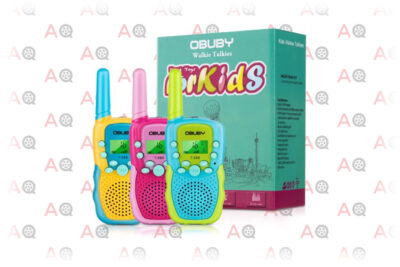
Editor’s Rating:
Quick Facts:
- VOX: Yes
- Earpiece Included: No
- Preprogrammed Privacy Codes: Yes
- License Required: No
- Maximum Range: 1.8 miles
- Battery Type: AA, 3-5 hours
- Durability: Excellent; waterproof
Obuby Walkie-Talkies for Kids come in a variety of cool colors and are great value for money, available in packs of 2 or 3. Not only are they designed to withstand the rough-and-tumble wear and tear of regular use by children, they’re also completely waterproof! Unlike many other walkie-talkies on the children’s market, you won’t have to worry about this one breaking after only a few days or weeks of use. To top it all off, they have excellent range and sound quality for a lower powered, FRS compliant device.
These two-way radios are ergonomically designed for small hands, with rounded corners and smooth rubber buttons. Your kids will have no trouble figuring out how to use these devices, as they have a very easy to use interface.
These walkie-talkies are equipped with an auto squelch function that cancels out background noise. They also have a built-in flashlight, ten different call tones, and a talk confirmation tone that automatically emits at the end of each transmission. While your kids will enjoy these funky noises, you unfortunately can’t turn them down.
Obuby Walkie-Talkie for Kids can transmit over 22 channels, and come preprogrammed with 99 different possible privacy codes for each. They also have a keypad lock, which allows parents to set these devices to a particular channel and privacy code in order to avoid interference with other radio users in your area.
One drawback with these two-way radios is the lack of a power-saver mode or automatic shut-off feature, so your kids will need to be diligent about turning them off completely when not in use. The battery life is also fairly short, at only 3-5 hours. Since each unit takes 4 AAs, we’d recommend investing in a set of rechargeable batteries.
Pros
- Waterproof
- Extremely durable
- Great range and sound quality
Cons
- Relatively short battery life
- Can’t turn down call noises
5. Motorola T100 Talkabout Radio

Editor’s Rating:
Quick Facts:
- VOX: No
- Earpiece Included: No
- Preprogrammed Privacy Codes: No, and not capable of being programmed
- License Required: No
- Maximum Range: 0.5 miles
- Battery Type: AAA, 18 hours
- Durability: Average; water resistant
The cheap and cheerful Motorola T100 Talkabout Radio is a trimmed-down, bare-bones walkie-talkie without any complicated bells and whistles. If your child is a pre-teen (or just a particularly austere younger kid) who wants a two-way radio without all the cutesy, colorful stylings you usually find on a kid’s model, this walkie-talkie is the perfect choice. It looks nearly identical to Motorola devices for the adult market, and comes in a pack of 2.
The Motorola T100 Talkabout Radio does its job pretty well for a low powered FRS radio. It’s got fairly clear reception, though the signal strength is quite limited —while Motorola claims it can transmit up to 16 miles, it’s really more like half a mile in usual conditions.
It has an auto squelch feature to cancel out background noise, as well as a call tone and talk confirmation tone. These can be disabled if you find them irritating, but you have to do it every time you turn on the device.
The Motorola T100 Talkabout Radio is capable of transmitting on 22 channels. However, only 1-14 are designated FRS channels. While it’s legal for your child to listen to channels 15-22 (which fall under the GMRS band), you’ll need to instruct them not to transmit on these channels.
Unfortunately, these walkie-talkies are not capable of supporting any privacy codes. If you live in a crowded area with a lot of interference, you’ll have a hard time finding a free channel.
At 18 hours, the average battery life is incredibly good, especially for a model that runs on AAA batteries.
Pros
- Excellent battery life
- Adult-looking design
- Reasonable sound quality
Cons
- No privacy codes
- No special features
- GMRS frequencies not locked out
6. Retevis RT628 Walkie-Talkie for Kids

Editor’s Rating:
Quick Facts:
- VOX: Yes
- Earpiece Included: No
- Preprogrammed Privacy Codes: Yes
- License Required: No
- Maximum Range: 1 mile
- Battery Type: AA, 8-10 hours
- Durability: Very good, water resistant
The Retevis RT628 Walkie-Talkie for Kids is a sturdy piece of equipment with a decent battery life and a good signal range. Sold in a pack of 2, it has a backlit LCD display and comes in black, red, silver, or camouflage.
For a low-powered 0.5W FRS compliant radio, it has a great range of up to 1 mile. The sound quality is terrific within this distance. The automatic squelch function effectively cancels out background noise to gives you crisp, clear reception —even in noisy areas. Unfortunately, you can’t turn down the call noises.
The Retevis RT628 operates on 22 channels, and comes with 121 privacy codes. The keypad lock feature allows parents to set it to a particular channel and privacy code, and prevents unintentional button dialing when it’s in your kid’s backpack.
Pros
- Excellent battery life for AA batteries
- Great sound quality
- Durable enough to be used by kids
Cons
- Can’t turn down call noises
7. Radio With Best Battery Life: BaoFeng BF-888S
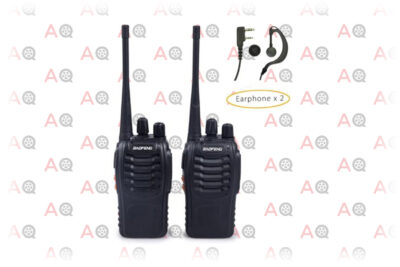
Editor’s Rating:
Quick Facts:
- VOX: Yes
- Earpiece Included: No
- Preprogrammed Privacy Codes: Yes
- License Required: Yes
- Maximum Range: 3 miles
- Battery Type: 1500mAh, 3.7V lithium-ion, 48 hours
- Durability: Very good; water resistant
For a basic, economical walkie-talkie, the BaoFeng BF-888S is extremely well-crafted. It has a 3W power output and is capable of dual band transceiving on UHF and VHF frequencies. The 1500mAh lithium-ion battery lasts about 48 hours and gives the device a range of roughly 3 miles. They come as a set of two, adding even more value.
The BaoFeng BF-888S has a power-saver mode, as well as a transmitter Time Out Timer (TOT), so you won’t completely drain the battery if the PTT accidentally gets pushed down for a prolonged period. An audible low voltage alert also lets you know when you need to recharge the device. It also has an emergency alarm, a broad/narrowband toggle, and a high illumination flashlight for nighttime use.
You scan through the channels using a rotary switch, while an English voice prompt lets you know what channel you’re on. There are 16 channels to choose from, and it comes preprogrammed with a total of 155 analog and digital privacy codes. While you can customize pre-set privacy codes for each channel, all programming must be done through a computer, since there isn’t an LCD screen.
Because it slightly exceeds the 2W limit for FRS radios, you technically need a license for the BaoFeng BF-888S. If you’re looking for an FRS compliant, license free two-way radio, try the newer BF-88ST model —it’s lower powered, but comes with a new integrated antenna and USB desktop charger.
Pros
- Extremely affordable
- Excellent battery life
- Fairly good range
Cons
- No LCD display
- Requires a license
8. Selieve Toys Kids Walkie-Talkies
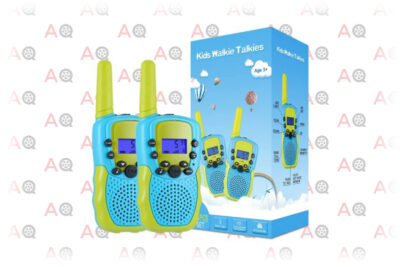
Editor’s Rating:
Quick Facts:
- VOX: Yes
- Earpiece Included: No
- Preprogrammed Privacy Codes: Yes
- License Required: No
- Maximum Range: 2 miles
- Battery Type: AA, 3-5 hours
- Durability: Very good; not water resistant
Selieve Toys Kids Walkie-Talkies are a great choice for kids on the go. They’re very portable, weighing only 90 grams. They come in a wide variety of nifty colors, like blue, purple, orange, red, and pink, and are sold in packs of 2. They’re also very durable, and designed to withstand being dropped from up to four feet.
The soft rubber buttons and a built-in LCD display make these easy to use. They also have a built-in flashlight and a ring function with several different tones that allows your child to alert you to their location from a distance. While this is a great alarm system, its volume isn’t adjustable.
These Selieve Walkie-Talkies have a 2W power output, with a very good range and great sound quality. They take 4 AA batteries each, and are equipped with an auto power-saver feature that darkens the LCD screen if no transmission has been sent or received in over five seconds.
Finally, they operate on 22 channels, and are capable of using 99 different privacy codes on each.
Pros
- Power-saver function
- Good range and sound quality
- Durable and attractive, making them great for kids
Cons
- Ringer can’t be turned down
9. Best Wearable Radio: Wishouse Wearable Walkie-Talkie
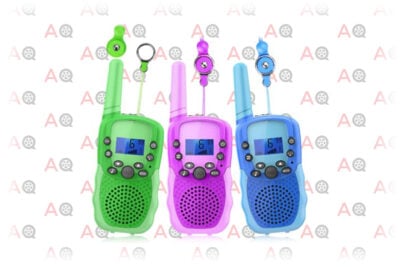
Editor’s Rating:
Quick Facts:
- VOX: Yes
- Earpiece Included: No
- Preprogrammed Privacy Codes: Yes
- License Required: No
- Maximum Range: 3 miles
- Battery Type: AA, 8-10 hours
- Durability: Very good, water resistant
These brightly colored walkie-talkies come equipped with an extendable (and detachable) lanyard that allows your kid to easily carry it around, preventing them from losing it. Sold in a pack of 3 or 4, Wishouse Wearable Walkie-Talkies are terrific value for money, and are available in green, purple, blue, and orange.
These two-way radios are FRS compliant, with a 0.5W power output. Despite their lower power level, they’ve got a decent range of about half a mile —up to 3 miles in an open area. The reception and sound clarity are excellent within this range.
Wishouse Wearable Walkie-Talkies have a built-in flashlight and an auto squelch feature for reducing interference. Your kid can also adjust the sensitivity of the VOX function for easy hands-free communication. They are drop resistant and water resistant.
These two-way radios can operate across 22 channels, with 99 privacy codes for each. Parents can also set the keypad lock to keep their kids tuned in to a particular frequency.
Each unit takes 4 AA batteries. While there is a power-saver mode, you’ll still have to remind your child to switch these devices off completely when they’re finished using them, since they don’t shut off automatically.
Pros
- Handy lanyard
- Excellent price-to-value ratio
- Good range for their power
Cons
- No auto-off function
- Low power
10. Most Durable Radio: Midland GXT1000VP4 Two-Way GMRS Radio

Editor’s Rating:
Quick Facts:
- VOX: Yes (adjustable)
- Earpiece Included: Yes
- Preprogrammed Privacy Codes: Yes
- License Required: Yes
- Maximum Range:
- Battery Type: 700mAh, 6.0V lithium-ion (or 4 AA), 10 hours
- Durability: Excellent; splash proof
The Midland GXT1000VP4 Two-Way Radio is a great pick for outdoor adventurers. Its 5W power output gives it terrific range and signal quality, while its tough, splash proof (misleadingly labeled “waterproof” in the product description) design make it a natural choice for braving the elements. It comes in a pack of 2 or 3.
A particularly cool feature with this two-way radio is the National Oceanic and Atmospheric Administration (NOAA) scan function, which will automatically find and lock onto the strongest available weather forecast channel for your region. It will alert you to severe weather risks in your area, too. It’s also equipped with an SOS siren for emergency situations.
The Midland GXT1000VP4 is designed for silent operation, and uses vibrations instead of caller tones. The “eVOX” (easy-VOX) feature has nine different sensitivity levels, allowing voice-activated transmissions even while whispering. This makes it ideal for hunting, bird watching, or simply maximizing your tranquility while enjoying the great outdoors.
The battery was a major issue with the Midland GXT1000VP4. Although it lasts almost 11 hours (thanks to its multiple power-saver settings), it takes just as long to recharge. You also can’t simply recharge the battery by itself, it has to be in the radio when you plug it in. While you can substitute the lithium-metal battery with 4 AA batteries, this reduces the power output to around 2W —the batteries will last longer, but the signal strength with be greatly reduced.
Lastly, this walkie-talkie has a total of 142 analog and digital privacy codes and operates on 22 different channels.
Pros
- Splash proof
- NOAA scanner/alert system
- Silent operation
Cons
- Slow battery recharge
- Can’t recharge battery separately from device
Be a Knowledgeable (and Responsible) Two-Way Radio Owner
For a device that’s essentially just an antenna, a battery, a microphone, and a speaker linked together by some internal circuitry, there’s quite a lot to learn about walkie-talkies! Here we’ll break down the key factors behind improving the maximum range of your two-way radio, and give you a more detailed explanation about privacy codes and licensing requirements.
Range
Walkie-talkies work by converting your voice into radio signals —denoted in “megahertz” (MHz), or millions of cycles per second— and transmitting them over the airwaves to other devices tuned in to the same frequency. The distance over which you can transmit is determined by numerous different technical and environmental factors.
It’s important to realize that literally every two-way radio (on this list and elsewhere) greatly exaggerates the maximum range of their devices in the product description. The signal distance claimed by these companies is typically based upon theoretical “optimal conditions” —you’d only ever encounter these if you were in the middle of the prairies (or on the open ocean), under ideal weather conditions, with absolutely no obstructions anywhere in sight.
The range of your walkie-talkie depends on a number of different things:
Power Output
The wattage of your two-way radio is definitely the most important factor in increasing the range of your device. Not only does a higher power level increase the signal strength of your walkie-talkie, but higher frequencies like VHF and UHF have a limited ability to penetrate through concrete, trees, and other obstructions.
Terrain
The ideal place to maximize the range of your walkie-talkie would be on a tall mountain overlooking a flat, open expanse, clear of forests, buildings, and other obstructions. However, in most places (especially if you’re transmitting from a valley, or in a densely populated city) you’ll find any unevenness in the natural terrain and/or any nearby tall buildings will cut your signal range dramatically.
Atmospheric Conditions
Weather plays a key role in how far you’ll be able to transmit on your two-way radio. Rain and/or electromagnetic interference can be particularly disruptive in terms of attenuating your signal.
Antenna
If you don’t mind modifying your walkie-talkie with an after-market part, attaching a larger antenna will significantly boost your signal range. Diamond and Nagoya both offer antennas that are compatible with most devices on this list.
Battery Condition
If your battery is drained, or simply too old to hold a complete charge anymore, this will negatively affect the power output of your two-way radio, which will diminish its range. Using a power saver mode will also have this effect.
FM Repeater Stations
Amateur radio clubs across the country have set up a network of antennas at various TV and radio stations that are capable of re-broadcasting your signal over hundreds of miles. Higher powered devices (GMRS and above) are capable of using these networks.
Privacy Codes
Privacy codes work by attaching a low frequency, inaudible squelching sound to your radio transmissions that works like a signal identifier. When you and the person with whom you’re communicating set your two-way radios to the same channel and privacy code, you will mute anyone else broadcasting on that particular channel. This will allow you to talk clearly without any interference from other radio users.
CTCSS and DCS
If this feature is important to you, look for radios with a CTCSS (continuous tone-coded squelch system), or its digital equivalent, DCS (digital-coded squelch). While CTCSS and DCS fulfill the same function, they aren’t compatible with each other.
The analog CTCSS codes run from 1-38 and can usually be mutually accessed even if the person you’re communicating with isn’t using the same brand of radio.
DCS codes run from 39 to well over 100. Because they’re more numerous, you’re less likely to run into interference while using DCS privacy codes. However, DCS privacy codes often aren’t compatible with each other if you’re using different brands of walkie-talkies.
If a two-way radio (such as the Midland GXT1000VP4 Two-Way GMRS Radio) says it has “3,124 channel options”, this means that it’s capable of using 142 different privacy codes on each of its 22 channels (3,124/22 = 142).
WARNING
It’s very important to note that, while your transmissions will be “encoded” with this feature, they are not actually encrypted —only military-grade radios are capable of blocking out other transmissions this way.
Given the sheer number of different privacy codes, you’re much less likely to encounter interference than you would on an unencoded channel, but this is no guarantee. Someone could still accidentally stumble upon the same channel and privacy code and interrupt your conversation.
Please keep this in mind, and remember not to discuss any confidential or sensitive information on your walkie-talkie.
Licenses
In the United States, in order to avoid interference with military, police, and emergency responder radio channels, the federal government has reserved certain frequency bands for public use. The primary two are the Family Radio Service (FRS) and the General Mobile Radio Service (GMRS).
FRS
The FRS band consists of 22 authorized channels at the 462 MHz and 467 MHz ranges. FRS compliant two-way radios don’t require a license to operate, and (unless you happen to be a representative of a foreign government) you’re allowed to use these frequency bands for either business or personal use regardless of how old you are —hence the name, “Family Radio Service”. Given that FRS devices cannot have a power output higher than 2W, their range is usually limited to only a few hundred feet.
GMRS
GMRS actually operates along the exact same frequency bands as FRS, just at a higher power output —up to 5W. This added power greatly increases the strength of your signal, allowing you to broadcast over much longer distances than FRS compliant devices. The GMRS frequency bands also allow you to connect to FM repeater stations (antenna set up on TV and radio towers by amateur radio clubs), which could theoretically relay your transmissions over a range of hundreds of miles.
However, in order to reduce congestion on the airwaves, the FCC requires GMRS users to obtain a license to operate on these frequencies. A few key details you should know:
- You must be at least 18 years of age to be eligible for a GMRS license.
- Anyone in your immediate family (regardless of age) will be legally covered under your license.
- Your GMRS license is valid for 10 years.
- There is no examination required.
- You will have to pay a one-time fee to the FCC.
- Your GMRS license is only valid for non-commercial use.
- You are only permitted to transmit on GMRS designated frequencies, and must stay within the power limitation assigned for each of them.
Getting a GMRS license is a fairly straightforward process:
- Go to the Universal Licensing System (ULS) section of the FCC’s website.
- Select “Register” and fill out the online questionnaire with your personal details.
- You will be assigned an FCC Registration Number (FRN) after completing the one-page form. At this point, you must also set a password for your new account.
- Once you have your FRN, login to your account through the “File Online” section of the ULS homepage.
- Select “Apply for a New License”, and pick GRMS from the drop-down menu.
- Finally, you will need to answer a few very basic questions, give payment for your GMRS license, and certify that the information you provided was correct.
- A hardcopy of your GMRS license will then be sent to the mailing address you provided.
Technician Class License
If you decide to purchase a walkie-talkie with a power output above 5W (such as the 8 Watt Ham Radio), you will have to obtain a Technician Class License from the FCC. The process for this is rather more difficult, and involves passing an in-person 35 question examination on radio theory, regulations, and operating practices.
The national association for amateur radio in the United States, the American Radio Relay League (ARRL), has a wealth of helpful resources about this licensing process on their website. These include everything from practice questions to finding an exam session in your local area.
Anyone considering taking up amateur ham radio as a hobby should seriously consider becoming a member of the ARRL. They provide all sorts of great instructional materials and tutorial guides for beginners that will really jumpstart your entry into the thriving subculture of ham radio enthusiasts.
WARNING
It is ABSOLUTELY NECESSARY to obtain a license from the FCC if you intend to operate on higher powered frequency bands such as the GMRS. Failure to comply with this requirement can result in a severe fine, often in the tens of thousands of dollars.
“Over and Out!”
We hope that our helpful consumer guide to two-way radios has presented you with enough options and information to choose the right product for your particular needs. From young backyard adventurers to mature, serious hobbyists, kids and adults alike are sure to find walkie-talkies a fun and rewarding way to communicate with one another.


